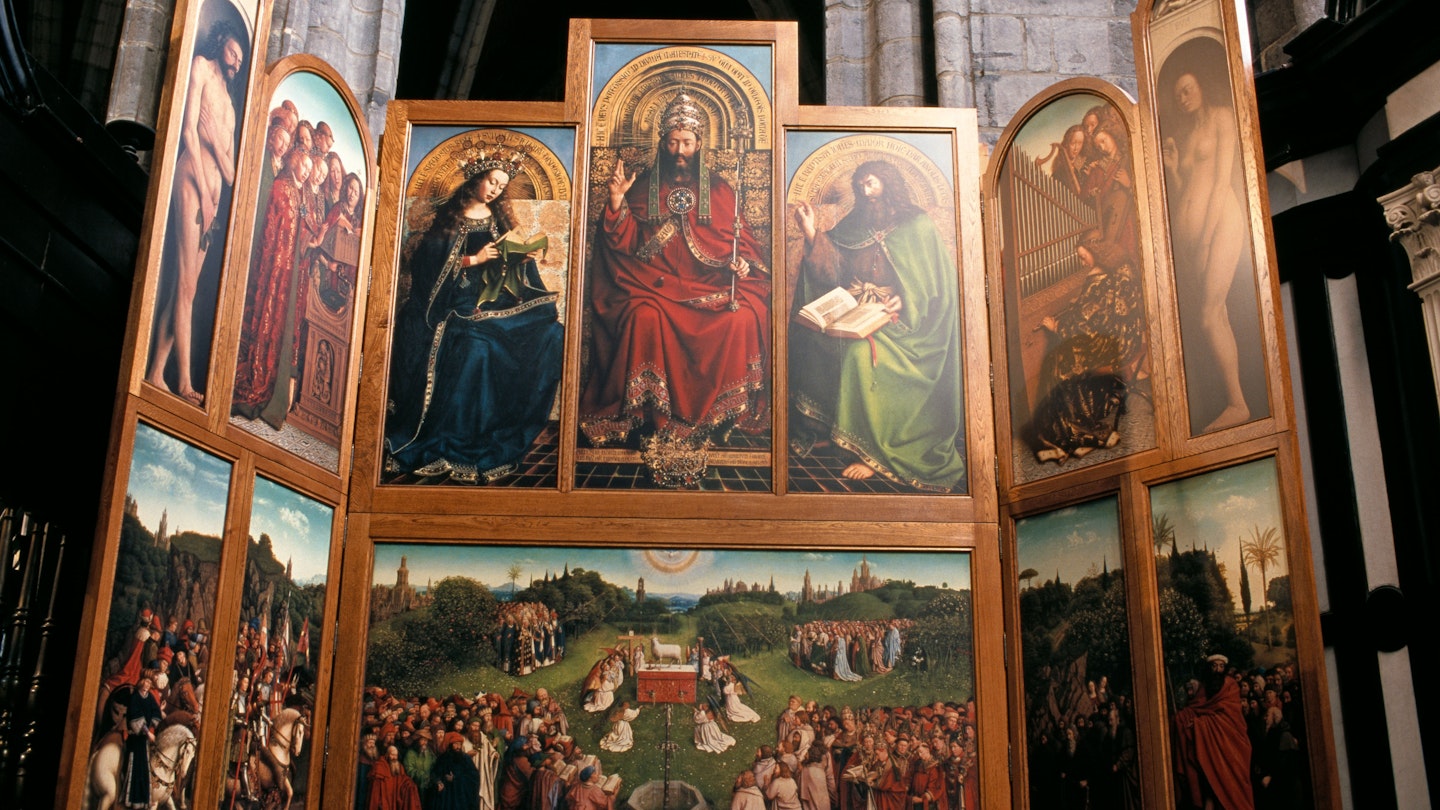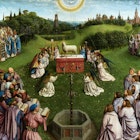
May 24, 2024 • 7 min read
Mar 3, 2020 • 5 min read

The Ghent Altarpiece inside St Bavo Cathedral. Invictus SARL / Alamy Stock Photo
The Belgian city of Ghent is associated with many wonderful creations: it even claims to have invented waffles. Its icon, though, is Jan van Eyck's Ghent Altarpiece, also called Adoration of the Mystic Lamb (Het Lam Gods in Flemish). In 2020, the city is focused on this magnificent painting, the highlight being a blockbuster exhibition called Van Eyck: An Optical Revolution (until 30 April).
The Ghent Altarpiece is an enormous painting that is displayed in St Bavo Cathedral. The painting is a triptych: an altarpiece with a large central section and on either side two “wing” sections on hinges, so the altarpiece can be opened or closed, and some of the panels are painted on both the front and back. The painting was begun by Hubert van Eyck in 1426, but Hubert died that same year, so it was completed by his younger brother Jan and finished in 1432.
{
"url": "ghent-altarpiece-tour",
"destination": "Ghent",
"continent": "Europe",
"country": "Belgium",
"city": "Ghent"
}
The Ghent Altarpiece is packed with superlatives. It was the first realist-style painting and the first great oil painting. It is easy to argue that it was the most influential painting ever made, since it was the most famous in Europe when it was completed, a point of pilgrimage for artists and art lovers, and it established oil painting as the preferred medium for the next 500 years. But it is also the most frequently stolen artwork in history. Everything bad that can happen to an artwork has happened to it: it has been burned in a fire, disassembled, nearly destroyed by Calvinist rioters, smuggled, forged and stolen (all or in part) on at least six occasions, including by Napoleon and the Nazis.
If you’re visiting Ghent, a great way to explore the city is to follow the sites linked to the painting. This walking tour visits key locations in the history of the Ghent Altarpiece, including a panel that was stolen in 1934 and remains missing. Who knows: if you keep your eyes open, maybe you’ll be the one to track it down?
The MSK (Fine Art Museum of Ghent) is housing the Van Eyck exhibition in 2020, and was the site of the restoration of the altarpiece from 2012–19. This is where conservators painstakingly removed numerous layers of paint and varnish that post-dated Van Eyck, and this restoration has in many ways altered the way art historians interpret and understand this famous painting. You can also see other paintings by Van Eyck here, as well as other Belgian greats like Brueghel and Magritte.
{
"url": "ghent-altarpiece-tour",
"destination": "Ghent",
"continent": "Europe",
"country": "Belgium",
"city": "Ghent"
}The 1913 World Fair was held in Ghent, and this bronze statue group was built to commemorate the Van Eycks. Hubert is a shadowy figure in the art world – there are no confirmed paintings by his hand, while Jan is world-famous. In fact, no one had ever heard of Hubert until a panel of the altarpiece was restored and an inscription was found stating that the masterpiece was begun by Hubert and finished by Jan, who is described as “second in art” (ie not as good as Hubert). But Hubert lived in Ghent, whereas Jan lived in the nearby rival city of Bruges, so the particular interest in Hubert among Ghentians has a measure of hometown pride about it.
On 19–20 April 1566, Calvinist rioters sought to destroy the altarpiece, as it was a symbol of Catholicism. It was preserved by local Catholics, who disassembled it and hid its panels in the bell tower of St Bavo Cathedral. The elaborate frame of the altarpiece was destroyed, but the rest of it survived, and when the rioting quelled, it was brought to the Gravensteen, a stout fortress in the centre of the city, for safekeeping until the Calvinists were no longer a threat.

During WWI, the Germans were determined to seize the Ghent Altarpiece as a trophy and for its symbolic value as the greatest treasure of Belgium. The army encroached on the city, but a brave local canon, Gabriel van den Gheyn, managed to disassemble the altarpiece and smuggle the panels away from the cathedral, by loading them into the bottom of a junk seller’s cart next to the Episcopal Palace. The panels were then hidden in various private homes until the Germans were vanquished.
{
"url": "ghent-altarpiece-tour",
"destination": "Ghent",
"continent": "Europe",
"country": "Belgium",
"city": "Ghent"
}Despite the stormy 600-year history of the Ghent Altarpiece, it is – almost miraculously – still mostly intact and on display in Ghent’s cathedral. All of the original panels can be seen here except one; the missing panel, called the Righteous Judges, was stolen in 1934 in a theft masterminded by a stockbroker named Arsene Goedertier, and hidden inside the cathedral. He sought a ransom for its return, but never came to an agreement, and died while the panel was still hidden. A copy of the missing panel can be seen displayed alongside the 11 original panels of the altarpiece.
The whereabouts of the original Righteous Judges panel remains a mystery to this day, but its path was traced to a number of locations before it ultimately disappeared. The panel remained hidden in St Bavo until Joseph Goebbels, Nazi Minister of Propaganda, sent an art detective to Ghent to find it in order to gift it to Hitler. Apparently the Nazi detective spotted the panel hidden underneath the stairs leading up to the rood loft, but before he could remove it, someone spirited it away, rather than let it fall into Nazi hands. It was likely next taken to the nearby Augustinian Monastery, and hidden behind the first confession booth on the left as you enter.
The panel was later moved from the Augustian Monastery and spent a long time hidden behind the altar screen at the parish Church of St Gertrude, just outside of Ghent – so long that dirt settled around it and an outline of the missing panel can be seen today.
The hunt for the missing panel remains active and Ghent police consider dozens of tips each year about its location. In 2018 police followed a tip that the lost panel was buried beneath the city's Kalandeberg Square, but nothing was found. The police felt obliged to issue a notice discouraging over-enthusiastic Ghent residents from digging themselves. Other recent investigations include searching beneath the floorboards of a private home and the excavation of a parking garage.
Brussels for art lovers: 10 incredible galleries
Antwerp: a modern creative powerhouse
Alternative destinations to escape the crowds in Western Europe
{
"url": "ghent-altarpiece-tour",
"destination": "Ghent",
"continent": "Europe",
"country": "Belgium",
"city": "Ghent"
}
Shopping
10 Brussels experiences that cost next to nothing – or are flat-out freeAug 26, 2024 • 6 min read

May 24, 2024 • 7 min read




Dec 17, 2021 • 7 min read

Jun 17, 2020 • 2 min read

Feb 18, 2020 • 6 min read

